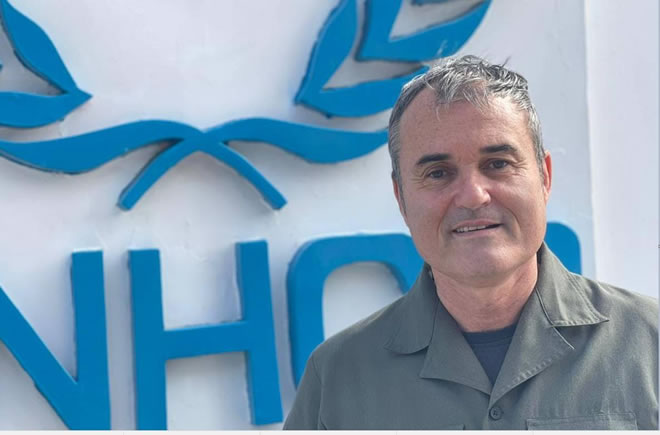
Saturday June 19, 2021

UNHCR Representative for Somalia, Johann Siffointe
On the eve of World Refugee Day marked every year on 20 June, UNHCR Representative for Somalia, Johann Siffointe, spoke with Hiiraan Online about the status of refugees, returnees and internally displaced people and the role his agency plays in protecting the forcibly displaced.
How many refugees, asylum seekers, returnees and internally displaced persons (IDPs) are in Somalia.
Somalia is host to more than 25,000 refugees and asylum seekers majority of whom are fleeing war or persecution from countries such as Ethiopia, Yemen, Syria, Eritrea and Tanzania. Over 700,000 Somalis are also refugees in countries across the region such as Kenya, Ethiopia, Yemen, Uganda, Djibouti and Eritrea. As the situation has continued to improve over the years, UNHCR has supported the return of more than 90,000 Somalis from countries of asylum through the Voluntary Repatriation Process (Volrep) and Assisted Spontaneous Returnees (ASR). More Somalis have been returning home spontaneously to take part in rebuilding the nation.
Somalia also has one of the largest IDP populations globally estimated at 2.9 million people. The displacement is mainly driven by conflict, floods and droughts.
Is displacement unique to Somalia or it a reflection of a global crisis?
Displacement is not unique to Somalia. More than 82 million people are currently living in forced displacement globally due to persecution, protracted wars, emerging conflicts and the effects of climate change. To put this in perspective, the current number of displaced people is larger than the entire populations of Somalia, Rwanda and Kenya combined. Sadly, most displacements remain in the African continent with Somalia being one of the main source countries of refugees.
What is the status of refugees and displaced people in Somalia and what impact has COVID-19 had on their living conditions?
For years, Somalia has maintained an open-door policy. Refugees live among locals in urban centers and can move around the country freely. However, refugees face many challenges including language barrier, limited job opportunities and poor living conditions. While we still do not have widespread outbreaks of COVID-19 cases in refugee populations or in the country in general, we are aware of refugees who have contracted the virus. Refugees are also struggling to meet their basic needs or provide for their families due to loss of jobs as well price increase of basic commodities. Since the outbreak of the pandemic, we have been working closely with government and aid agencies to ensure refugees who contract the virus are isolated and treated.
Most IDPs in Somalia live in makeshift shelters where they are exposed to extreme weather conditions, disease and fire outbreaks. They lack basic services such as clean water and proper sanitation and are at high risk of eviction as they lack security of tenure. Women in IDPs settlements are also at a higher risk of sexual and gender-based violence.
What are some of UNHCR’s interventions to protect refugees and displaced families?
UNHCR has been operating in Somalia for close to 30 years providing protection and lifesaving assistance to those forced to flee their homes as well as the host communities. We support communities with cash grants, emergency and provisional shelters, access to education, healthcare, livelihood initiatives and community-based projects.
Following the outbreak of the COVID pandemic, we stepped up our response by putting measures in place to protect refugees and communities hosting them from contracting the virus. Such measures include sensitization campaigns, distribution of cash and food assistance, setting up hand washing facilities, distribution of soap and making masks available.
How has UNHCR supported government agencies to ensure refugees and displaced people find lasting solutions?
UNHCR has enjoyed a strong partnership with the authorities in Somalia since it made its footprint in the country 30 years ago. We provide material and technical support to federal and regional states that offer protection to refugees and other displaced populations. They include the National Commission for Refugees and IDPs (NCRI), Jubbaland Refugees and IDPs Affairs Commission (JRIA), National Displacement and Refugee Agency (NDRA), South West Commission for Refugees and IDPs (SWCCRI) and Puntland’s Ministry of Interior Federal Affairs and Democratisation (MoIFAD).
Our material support includes construction and rehabilitation of community-based projects in areas with high populations of refugees, returnees and IDPs. Such projects consist of schools, hospitals, police posts, markets, boreholes and shelters. Technical support to the government includes drafting of key legal instruments that are vital in protecting the rights of refugees and other displaced populations. Last year for example, UNHCR offered expert support to the National Commission on Refugee and IDPs (NCRI) in drafting the Refugee Bill. We also supported the government in drafting a National IDP law. Both the Refugee and National IDP Bills are awaiting debate by the Somali Lower House of Parliament.
As part of our COVID-19 response, UNHCR will continue to support health ministries and local hospitals with essential medical supplies and personal protective equipment (PPE) consisting of medical tents and beds, oxygen cylinders, surgical masks and gowns, gloves, face shields and sanitizers.
What is your current financial outlook this year?
We are living in unprecedent times with our donors equally grappling with the economic effects of the coronavirus as well as multiple humanitarian emergences across the world. Out of the USD 157.7 funding requirement for UNHCR Somalia, we have only received 12 percent to date. We continue to lobby for more funding to help us protect vulnerable refugees and displaced families.